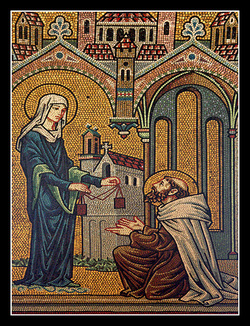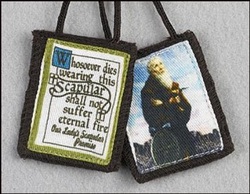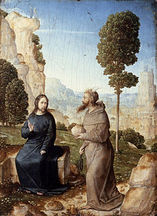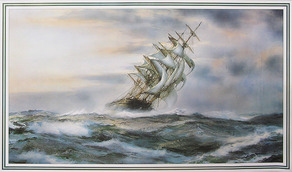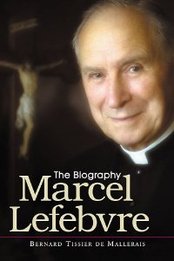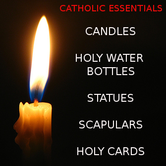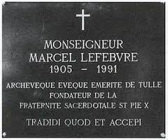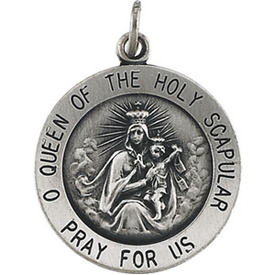 Scapular Medal used only when you can't wear cloth
Scapular Medal used only when you can't wear cloth It is apparent that the Holy Father did not change the Sign of Mary's Confraternity in order to truckle to the fashions of the day. During the several days in which His Holiness was deliberating about conceding the Scapular Medal, one of the Cardinals approached him with what he thought to be a very strong objection. "Your Holiness," he said, "to grant the Medal would seem an admission to objectors that the Blessed Virgin never appeared to Saint Simon Stock." Probably the Cardinal did not understand the real meaning of the Scapular Promise but the Pope simply turned and said brusquely: "But I believe in the Scapular Vision!" And, as the Vicar of Christ, in granting the Medal he said: "I desire most vehemently that the cloth Scapulars be worn as heretofore."
Many did not see, or at least professed not to see, that the Sovereign Pontiff only willed the Medal to take the place of the Scapular in case of necessity or for very serious reasons. The Medal became widespread, not without some injury to the devotion. However, the actions of the successors of Pius X leave no doubt that we should not wear the Medal in place of the Scapular without sufficient reason, and since no official pronouncement has been made, one who does wear the Medal without sufficient reason runs the danger of not receiving the Promise. Mary cannot be pleased with one who changes Her gift out of vanity or fear to make open profession of his affiliation to Her. Moreover, the cloth Scapular has seven centuries of sacred tradition behind it. It has become redolent of the fragrance of Our Heavenly Mother. Not only was it by that Habit that She originally took unto Herself "special children of love", as the Church sings in the Preface of Her special Mass for July 16th, but it has been the vehicle of numerous miracles. Those two bits of cloth have extinguished tremendous fires and then have been taken intact from the glowing embers! They have been found miraculously preserved in the tombs of Saints where everything else had turned to dust! Often people miraculously preserved from a watery grave have found their little habits perfectly dry, the added miraculous touch of a Mother who not only protects us but wants to show us that She does so, because She loves us as Her special children. The Medal has never seen any of these things; it is sure that, as a substitute for the Habit, it can mean as much as the cloth Scapular only to one who cannot wear the cloth Scapular.
But Pope Pius XI has made it possible for everyone to wear the cloth Scapular. By a decree of May 8, 1925, this great Pontiff approved what is known as the "protected Scapular". Instead of just the two pieces of brown cloth joined by string or cord, one may wear the two pieces of cloth joined by chains and enclosed in cases.
There are, consequently, few remaining reasons for Americans or Europeans to be without the cloth Scapular. To prevent being conspicuous, one may sew or pin the Scapular to an undergarment so that it cannot rise and show about the neck. To prevent irritation of sensitive skin one may resort to some sort of covering over the Scapular, perhaps of oil-silk or of cellophane. Moreover, as was stated previously, not only may the Scapular be encased but the strings may be white or blue, satin or cotton . . . of any color and of any material. Consequently it should certainly be no more difficult to wear the small Scapular than it is to wear any other undergarment.
The first successor of Pius X, His Holiness Pope Benedict XV, declared on July 8, 1916: "In order that one may see that it is Our desire that the Brown Scapular be worn, We concede to it a grace that the Scapular Medal shall not enjoy." And the Pontiff proceeded to grant an indulgence of five hundred days for each time the Scapular is kissed!
After the Scapular Medal legislation, Cardinal Mercier wrote: "It is so popular among us to wear the Scapular that we should see with the greatest disgust that, without any foundation, so laudable a custom might be lost; let us use the medal only when we have some real inconvenience in wearing the Scapular." And Father Vermeersch, S. J., said: "I would prefer that in order to honor the principal Scapular which is that of Carmel, the Brown Scapular be worn in the accustomed form and the medal only as a substitute for the other scapulars in order that one may not have to wear too many." Hence it would be wise never to use the Scapular Medal in place of the Brown Scapular but only together with the Brown Scapular as a substitute for the less important scapulars.
We have summarily analysed, therefore, the meaning of those first words of the Promise: "Whosoever dies clothed in this Habit." Our Lady made a Promise of Salvation to all who die in Her Family of Carmel; so to die, one has to be validly enrolled in the Habit of that family and perseveringly wear it.
Now we turn to understand a little more fully the most astounding promise itself, viz., that those who die in Mary's family shall not suffer the fires of Hell.
As was said in the beginning of this chapter, Our Lady's Promise does not mean a removal of God's sanction of the moral law, i.e., that regardless of what we do we shall not be eternally punished. Saints and Pontiffs often warn us of the foolhardiness of abusing Mary's Promise. At the same time that he joyfully professed: "I learned to love the Scapular Virgin in the arms of my mother," Pope Pius XI warned all the faithful that "although it is very true that the Blessed Virgin loves all who love Her, nevertheless those who wish to have the Blessed Mother as a helper at the hour of death, must in life merit such a signal favor by abstaining from sin and laboring in Her Honor". One can take it as certain that if he continually sins because of Mary's Scapular Promise, he shall not die in the Scapular. To lead a sinful life while trusting in the Scapular Promise is to commit a sin the horror of which borders on sacrilege; its punishment will not only be eternal but far worse than if one had led a sinful life without making the Mother of God an excuse for crucifying Her Son . . .
There are times when a person is tempted to some great sin, such as impurity or theft, that the suggestion comes: "Why not do it? You wear the Scapular and after this moment is passed you will still have no fear about your eternal salvation." It is Satan using the Scapular Promise to draw a soul to sin, a worse sin than the objective act itself. Like all sin, it can become a habit. A typical and warningful example is found in a certain well-testified Scapular miracle. A man openly excused a wicked life by boasting that he wore the Scapular; he claimed surety of salvation while he dis-edified his neighbors by abominable excesses. In this presumptuous belief he persevered until death overtook him. Then those whom he had dis-edified became witnesses to an event that has not been uncommon in the years that men have sought to realize Mary's promise. As death approached, the poor wretch thought that the Scapular was the cause of his agony. He cried out painfully that it was burning him. In a last supreme effort, tearing it off, he flung it from him...and went to meet a Divine Judge.
Mary's promise is the masterpiece of Her motherly love. It was made to be a source of hope and confidence to us. In the supreme moment of our lives— the moment when we feel this earth slipping away with all that it has meant to us while a strange life yawns at our feet into eternity, we need a mother. Probably it was at the foot of the Cross, the moment when Her Divine Son made Her our Mother in a gesture of death-parting, that Mary thought to assure us of a Mother's love at our dying moment. Soldiers cast lots over the earthly garments She had made for Her crucified Redeemer; She would make a heavenly garment for Her Blood-purchased redeemed.
"Whosoever dies clothed in this Scapular shall not suffer the fires of hell." . . . Savaria remarks that it is these words, so very extraordinary, that comprehend the full value of the Brown Scapular. "One cannot descend too far into their depths," he says. "It is only by penetrating beyond the sensible that one comes to know the spiritual treasures which this Heavenly Garment conceals. Especially today, with the power of Satan threatening to shake the very foundations of the world, we need a rational knowledge of our devotions and above all of Her who crushes the head of the infernal serpent."
Yes, we need Mary today with Her Satan-crushing prayer. Her great promise must be understood because we also need the union that it has established. We need "Her family," both as corporate members of a militant Church against Satan and as individual warriors with a private battle. Pope Benedict XV, addressing the seminarians of Rome one July 16th, said: "Let all of you have a common language and a common armor: the language, the sentences of the Gospel; the common armor, the Scapular of the Virgin of Carmel, which you all ought to wear and which enjoys the singular privilege of protection even after death."
Hence it is only natural that we seek to have a rational knowledge of the Scapular Promise. And although the words of Our Lady's Promise are clear, how sure are we that She spoke them? And how can it be that for wearing two pieces of cloth, She saves us? What is the meaning of that denomination of the Scapular, which one hears so often, Mary's Sacrament? Is the wearing of Mary's Sign really a devotion? Is it really an armor that should be as common in the Church as the language of the Gospel? Does it really assure salvation and, then, aid us even after death?
These are a few apparent questions that probably flock to the reader's mind upon understanding the meaning of Mary's words and hearing that they have some very deep significance. And as he looks further at the Scapular, further questions will arise until he will, most probably, find himself mute before the overwhelming magnificence of Mary's gift.
"In admitting me into her Family of Carmel, Mary promises me three great favors. She will protect me in danger, She will help me to die well, and She will promptly aid me after death. It is She Herself who has assumed all these obligations in my regard.""
Fr. chaignon, S. J.
"We believe that all those who have the happiness of wearing the Scapular while dying, obtain Grace before God and are preserved from the fire of hell, because we believe that Mary, to keep her promise, draws forth for them from the divine treasures of which She is the depository, the graces necessary for their perseverance in justice or their sincere conversion. And thus fortified, and reconciled with God through the Sacraments of perfect contrition, the associates of the Scapular, dying in this Holy Habit, do not fall under the blows of an inexorable justice.
R. P. Maurel, S. J.

